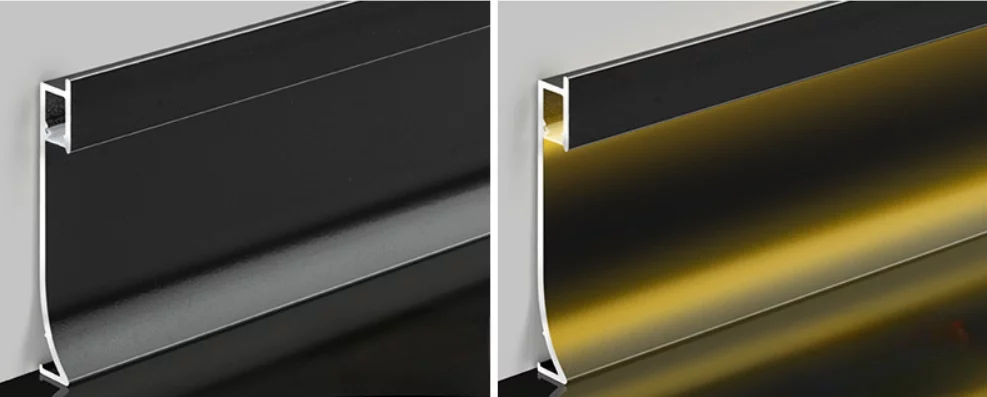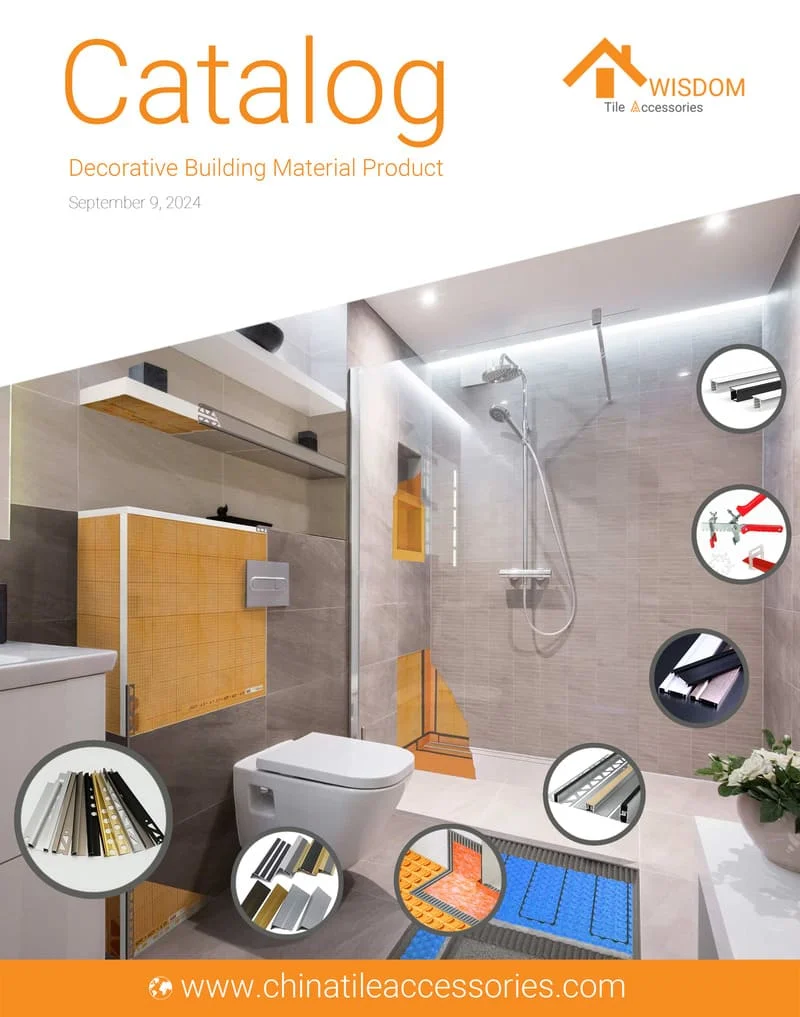Are you still using traditional hardwood skirting board? In fact, LED baseboard is the trend in modern interior design. According to statistics, 78.95% of contractors choose LED baseboard as a lighting solution in their construction projects. Through this article, you will learn all you need to know about baseboard led lighting, including concepts, types, options, installation methods and more.

What is Baseboard LED Lighting?
Baseboard LED lighting is a modern lighting solution that integrates LED strip lights within the baseboard profiles, discreetly positioned at the intersection of walls and floors.
This innovative lighting approach serves dual purposes: it enhances the aesthetic appeal of a space by providing a subtle, ambient glow, and improves visibility, especially in dimly lit areas.
Constituting elements include an aluminum base profile, an LED diffuser or cover to evenly distribute light, end caps to seal the profile, connectors for seamless integration, and an LED driver to power the system.
Available in various dimensions and styles, baseboard LED lighting is designed to complement the architectural details of any room, offering a contemporary and sophisticated touch to home decor while also contributing to the overall lighting scheme.
This form of lighting is particularly favored for its energy efficiency, long lifespan, and the ability to fit seamlessly into different design aesthetics.

Types of Baseboard LED Lighting Solution

Recessed Baseboard Lighting
Recessed baseboard lighting is installed into a groove or recess within the wall or floor, allowing the lighting element to sit flush with the surface. This type offers a streamlined, minimalist aesthetic, minimizing visual intrusion while providing a continuous band of light along the base of a room.
It's particularly suited for modern interiors, emphasizing clean lines and unobtrusive design. The installation requires pre-planning and space within the wall or floor to house the lighting mechanism.

Surface-Mounted Baseboard Lighting
Unlike recessed lighting, surface-mounted baseboard lighting attaches directly onto the surface of the baseboard or wall. This method is more straightforward to install, making it a viable option for retrofitting existing spaces without significant structural alterations.
Surface-mounted lighting units are more visible than their recessed counterparts but can be designed to complement the room's decor. They provide flexibility in installation and are ideal for situations where embedding lighting into walls or floors is not possible.

Modular Illuminated Baseboards
Modular illuminated baseboards consist of pre-fabricated segments that can be assembled and customized to fit specific dimensions and requirements of a space. These systems typically include segments of LED strips, diffusers, end caps, and connectors, allowing for a highly customizable lighting solution.
They are adaptable to various lengths and shapes, making them suitable for different room layouts. Modular systems offer the advantage of easy installation and replacement, catering to both permanent installations and temporary setups needing adaptable lighting solutions.
Material and Design Choices
Aluminum Alloys and Natural Aluminum:
- Thermal Conductivity: Suitable for heat dissipation from LEDs.
- Durability: Resists corrosion, lightweight.
- Customization: Available in various finishes.
- Eco-Friendly: Recyclable, supports sustainable practices.
- Application: Common in residential and commercial settings due to versatility.
Stainless Steel:
- Durability: High strength, fire and chemical resistant.
- Maintenance: Low maintenance, resistant to corrosion.
- Application: Used in environments requiring extra strength or specific aesthetics like medical or food-processing areas.
Each material has unique properties catering to different environmental conditions and design requirements. Choose based on thermal management needs, environmental conditions, and design compatibility.

Pros and Cons: Do You Need Led Baseboard?
Pros
Aesthetic Appeal: LED baseboard lighting enhances interior design, adding a modern, sleek look. It highlights architectural features and outlines spaces, creating an inviting atmosphere.
Energy Efficiency: LEDs consume significantly less energy compared to traditional lighting, leading to lower utility bills. Their efficiency is beneficial for reducing environmental impact.
Safety and Comfort: LED lights emit minimal heat, reducing the risk of burns and fire hazards. They contribute to a safer environment, especially important in homes with children and pets.
Customization: Offers flexibility in terms of colors, brightness, and effects. Users can tailor lighting to match mood, activity, or time of day.
Cons
Initial Cost: Higher upfront costs than traditional baseboards. While LED technology saves money over time, the initial investment can be a barrier.
Installation Complexity: Requires planning and possibly professional installation, particularly for recessed types. The process can be intricate, depending on the existing infrastructure and design requirements.
Technical Challenges: Involves considerations like voltage, compatibility with existing systems, and proper heat dissipation. Incorrect installation can lead to operational issues.
When considering whether to install LED baseboard lighting, weigh these pros and cons against your personal needs, the specific characteristics of your space, and your budget.
How to Select a Suitable Light Strip for Baseboard?
Selecting the right light strip for your baseboard LED lighting involves considering several factors. The correct light strip will not only enhance your space's aesthetics but also provide the desired level of illumination.
Brightness and Wattage:
- Match the lumens (brightness) to the intended use; ambient lighting requires less brightness than task lighting.
- Consider wattage in relation to energy consumption and heat generation; lower wattage is preferred for energy efficiency.
Color Temperature:
- Choose a color temperature that suits the room's ambiance; warm whites for cozy spaces, cool whites for workspaces.
LED Density:
- Determine the number of LEDs per meter; higher density for uniform light without dark spots.

Voltage and Power Supply:
- Select a strip compatible with your electrical system's voltage.
- Ensure the power supply can handle the total wattage of the strip plus a 20% overhead.
Dimming Capability:
- If dimming is required, ensure the LED strip and controller are compatible.
IP Rating:
- Consider the installation environment; higher IP ratings for wet or outdoor areas.
Length and Flexibility:
- Measure the required length; ensure the LED strip can be cut or linked as needed.
- Consider flexibility if bending around corners or curves.
Installation Method:
- Check compatibility with the baseboard profile; ensure secure attachment and heat dissipation.
Quality and Warranty:
- Opt for strips from reputable manufacturers with warranties for reliability and longevity.
Choose based on specific needs regarding brightness, color, efficiency, and installation environment to ensure compatibility and optimal performance.

How to Install Aluminum LED Baseboard?
When installing aluminum LED baseboards, there are several methods to consider, each with its unique characteristics and installation requirements. The choice between surface-mounted, concealed installations, and different lighting directions like top glow, bottom glow, slant glow, or side glow depends on the desired aesthetic effect and the structural conditions of the space.
Surface-Mounted
This method involves attaching the LED profile directly onto the surface of the wall or baseboard. It's straightforward, suitable for retrofit projects, and does not require significant alterations to the existing structure. Surface-mounted installations are visible but can be chosen to complement the room's design.
Concealed Installations
Concealed or recessed installations involve embedding the LED profile into the wall or baseboard, making the lighting element invisible when not in use. This method requires more planning and possibly structural modifications but results in a sleek and seamless appearance.
Top Glow
Top glow installations direct light upwards, creating a soft illumination that can enhance the ambiance of a room or highlight architectural features above the baseboard.
Bottom Glow
The bottom glow directs light downwards, illuminating the floor. This can add depth to a room and is often used for pathway lighting or creating a cozy atmosphere.
Slant Glow
Slant glow installations angle the light diagonally, providing a unique lighting effect that combines the features of top and bottom glow. It's ideal for creating dynamic lighting schemes.
Side Glow
Side glow directs light horizontally, illuminating the area adjacent to the baseboard. This method is less common but can be used for accent lighting or in narrow spaces where other lighting directions are not feasible.
Each installation method offers different visual effects and practical benefits. The choice should be based on the specific requirements of the project, such as the desired mood, the function of the room, and the physical constraints of the installation space. Detailed planning and consideration of the LED strip's specifications, such as brightness, color temperature, and IP rating, are crucial for achieving the best results.
Want to See More about LED Baseboard?


How to DIY LED baseboards?
To embark on a DIY LED baseboards project, consider the following steps, focusing on customization and utilizing available services and products to create a personalized lighting solution:
- Design Planning: Begin by visualizing the desired outcome for your space. Determine the location, length, and effect (e.g., ambient, accent) you want from your LED baseboards. Consider different lighting directions (top glow, bottom glow, etc.) based on the room's function and ambiance.
- Material Selection: Choose the appropriate materials for the baseboard. Aluminum profiles are commonly used due to their durability, heat dissipation properties, and aesthetic appeal. Decide on the finish and color that match your room's design.
- LED Strip Selection: Choose LED strips considering brightness, color temperature, and IP rating (for moisture resistance). The strip should fit within the aluminum profile and suit the intended lighting effect.
- Cutting and Assembly: Measure and cut the aluminum profiles and LED strips to the required lengths. Foshan Awidom Metal offers customization services such as custom manufacturing and cutting to size, which can simplify this step.
- Waterproofing (if necessary): For areas exposed to moisture, consider waterproofing solutions. Aiwsdom provides LED resin filling services to ensure your LED baseboards are protected against water damage.
- Installation: Install the baseboard profiles at the desired location. For surface-mounted designs, attach directly to the wall or existing baseboards. For concealed installations, you may need to create a recess in the wall. Ensure that the installation is level and secure.
- Wiring and Connection: Safely connect the LED strips to the power supply and controller, ensuring that all electrical connections are secure and comply with local regulations. Consider using connectors and cable management accessories to maintain a clean setup.
- Testing and Customization: Before finalizing the installation, test the LED baseboards to ensure they work correctly. Adjust the light settings according to your preferences, using controllers or dimmers for dynamic effects.
- Final Touches: Once satisfied with the lighting effect, secure all components and conceal any visible wiring for a polished look. Apply finishing touches such as paint or end caps to match the surrounding decor.
By following these steps, you can create unique and personalized LED baseboard lighting that enhances the aesthetic and functionality of your space. Remember, while DIY projects can be rewarding, always prioritize safety, especially when dealing with electrical components. If unsure, consult with a professional.
For detailed information and services, check out our skirting boards or contact our professional for specific customization needs.
FAQ: LED Baseboard Lighting
Can LED lights be placed on wood?
Yes, LED lights can be placed on wood surfaces. However, ensure the wood is not near high heat or moisture areas and the LED strip does not overheat.
Is it safe to put LED lights on walls?
Yes, it is safe to mount LED lights on walls. Use appropriate fixtures and ensure they are installed away from flammable materials.
Why are LED lights not suitable for enclosed fixtures?
LED lights may not be suitable for enclosed fixtures due to heat accumulation, which can reduce the lifespan of the LED. Always check the bulb's compatibility with enclosed fixtures.
Is it safe to use LED bulbs in enclosed fixtures?
Some LED bulbs are designed for use in enclosed fixtures, but you should verify this by checking the product specifications.
Can you put LED lights on baseboards?
Yes, LED lights can be installed along baseboards. They are used to create accent lighting and illuminate walkways.
Can you cut LED strips and they still work?
Yes, LED strips can be cut at designated points, marked by a line and scissors icon, without damaging their functionality.
What are the 2 types of LED light strips?
The two main types of LED light strips are single-color (monochrome) and RGB (color-changing).
Can you cut Govee LED lights?
Yes, Govee LED lights can be cut at specific sections, usually marked along the strip. Ensure you cut only at these designated points to maintain functionality.
Where should you not use LED bulbs?
Avoid using LED bulbs in environments with extreme temperatures, within totally enclosed fixtures (unless specified), and in areas with high humidity, unless they are rated for such conditions.
Do you need a special fixture for LED lights?
Not necessarily. Many LED bulbs are designed to fit standard fixtures, but some applications, like dimming or enclosed fixtures, may require specific types of LEDs or additional equipment.
Do I need an electrician to install LED lights?
For simple installations, such as plug-in LED strips, you might not need an electrician. However, for hardwired LED fixtures or complex setups, hiring a professional is recommended for safety.
Why do LED light bulbs not work in some fixtures?
LED light bulbs may not work in some fixtures due to compatibility issues with dimmers, enclosed designs causing overheating, or voltage mismatches.
Can you put LED lights in old fixtures?
Yes, LED lights can often be used in old fixtures, provided the voltage and fitting types match. However, the fixture's condition and compatibility should be assessed.


